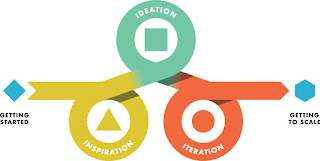This was a great, inspiration talk by Dan Buchner of the Peter Lougheed Leadership Institute, Banff Centre. Very encouraging for collaborative, user centered, culture of yes thinking and leadership. Here are my disjointed notes.
Keep the change video from Bank of America an example of Design Thinking.
Putting people first is the basis of Design Thinking.
What are people's priorities, problems, interests. Design thinking is biased towards action, human centered, collaborative, iterative, learning. It's the 'try it' mentality.
Check out designthinkingforlibraries.com and get the downloadable .pdf. Graphic below is from the site.
To start the problem solving process, frame an opportunity statement. This statement must follow this criteria:
- 7 to 10 words
- Free of jargon
- Free of criteria
- Affirmative in orientation
- Identify the owner of problem
- Include action verbs
- Include objective or goal
- Start with the word: How do we ..... Or In what ways might we..... Or How we might ....
One person asks the questions, one person observes the interview The observer tracks what is observed and what is discussed
Example:
What do you like about where you live
What is important to you about the place where you live, what do you value
How did you find the this place
The question was: Selecting an apartment to rent/house to buy
Though the speaker didn't have time to go into it he did suggest that hand in hand with design thinking is the concept of Empathy Mapping. There's a fairly good blog post at http://www.copyblogger.com/empathy-maps/ on the concept.
Wonderful speaker, definitely one that I'd recommend to any conference planner.

No comments:
Post a Comment